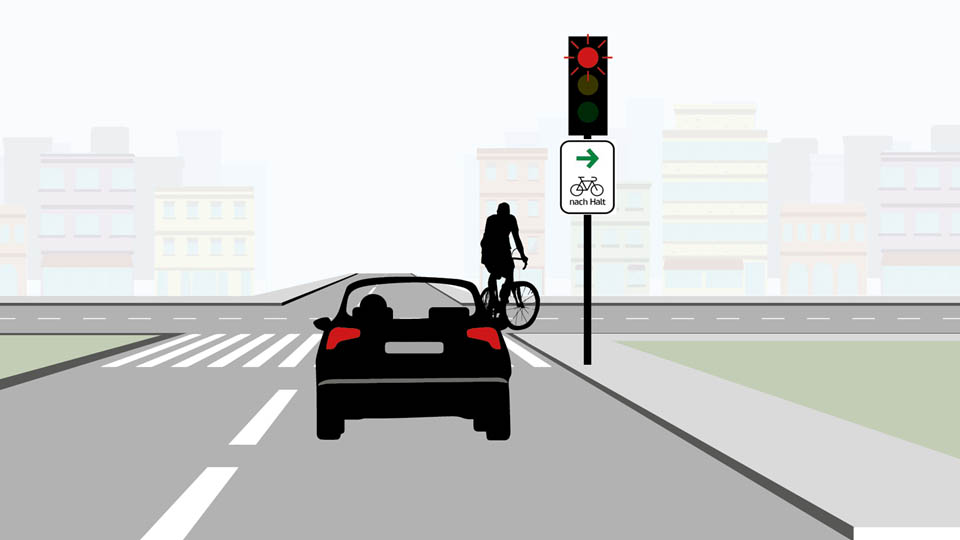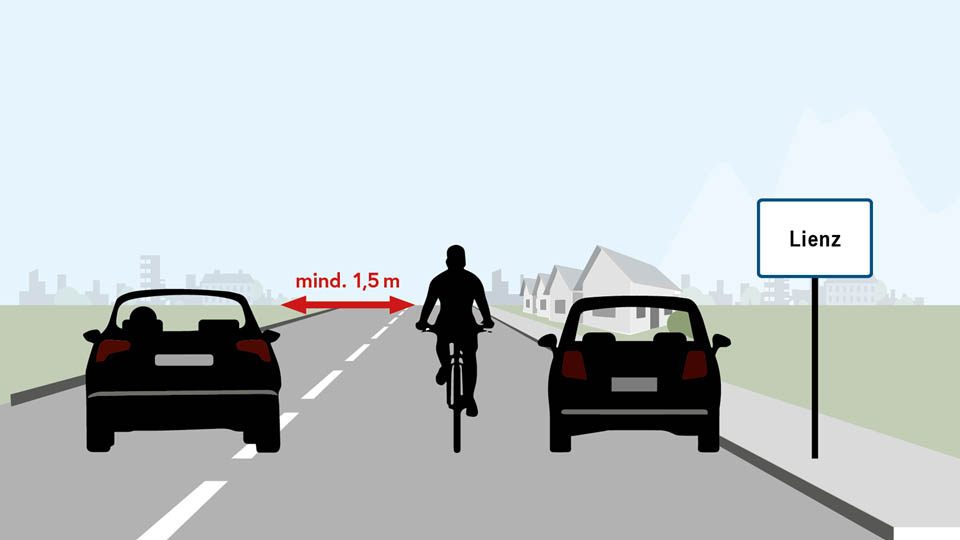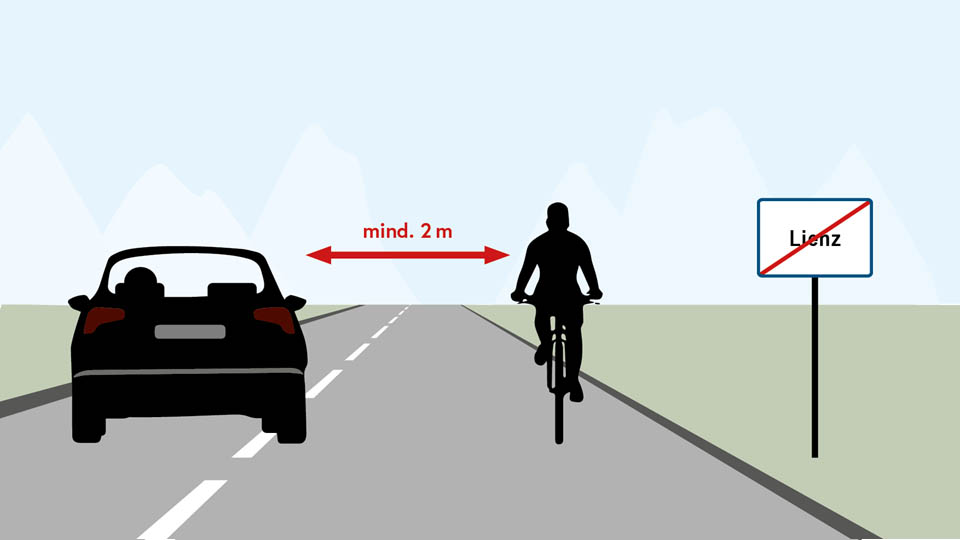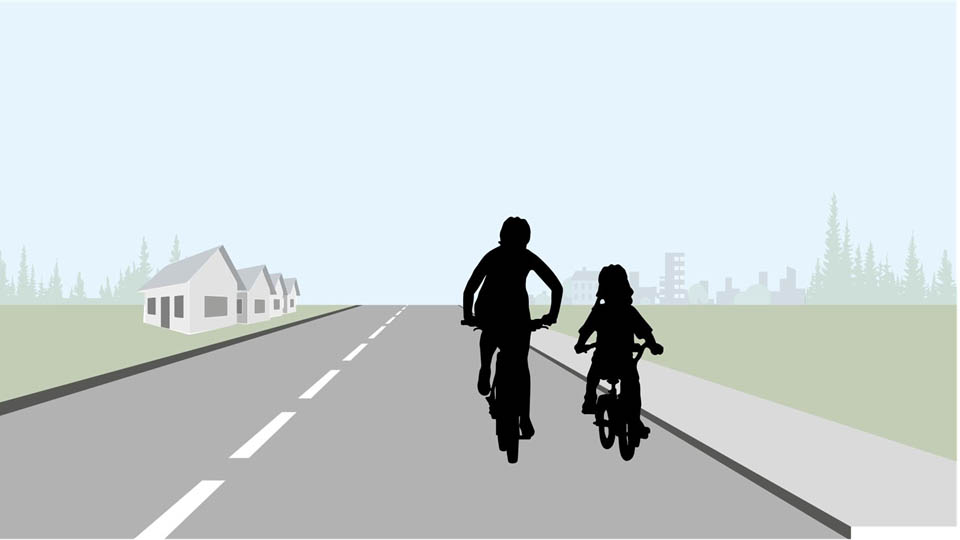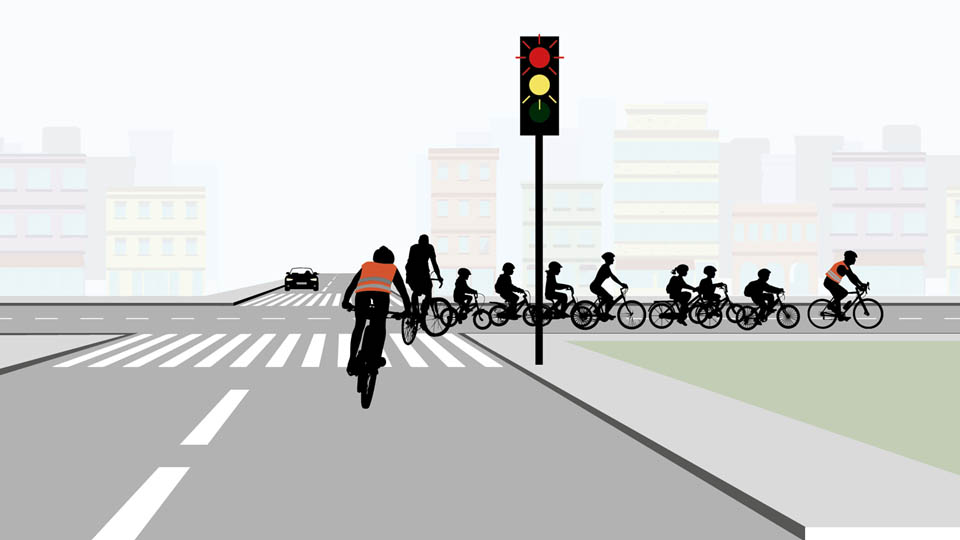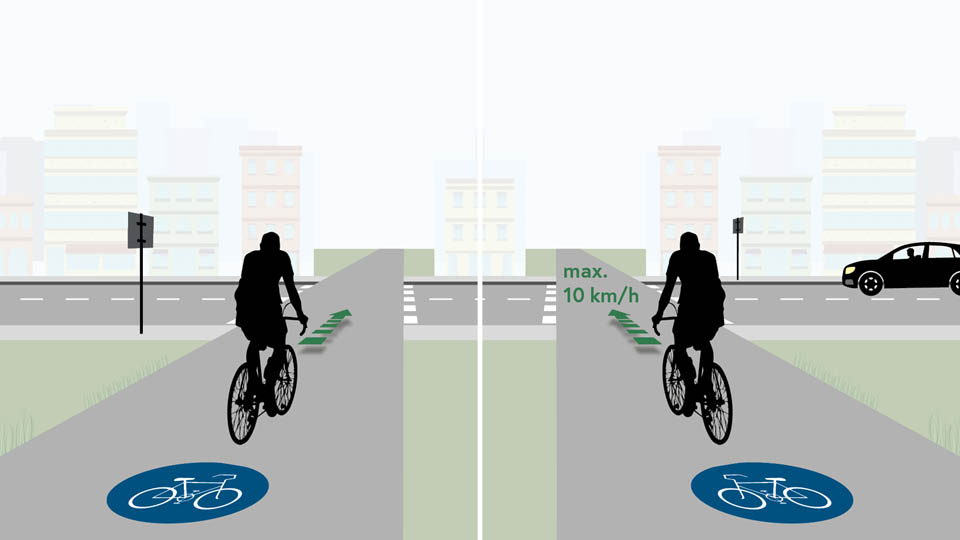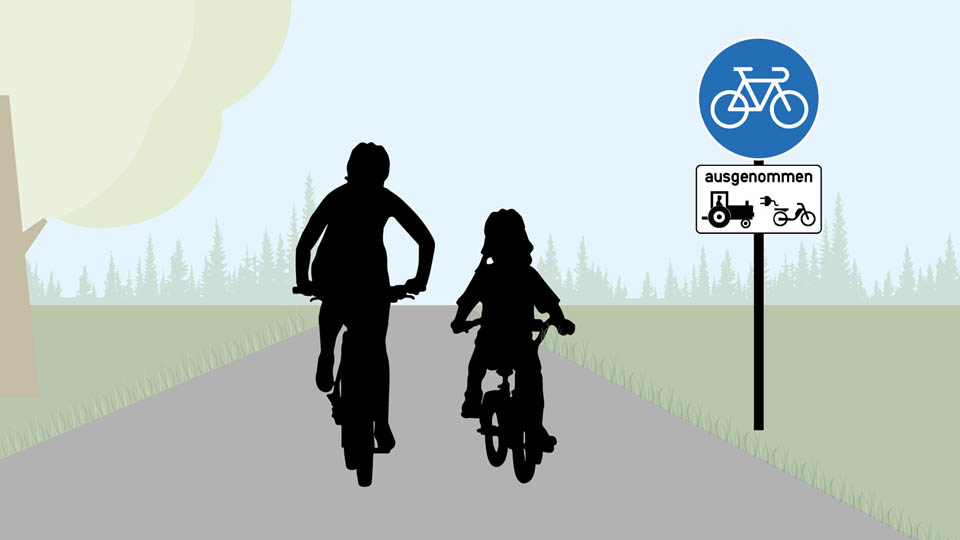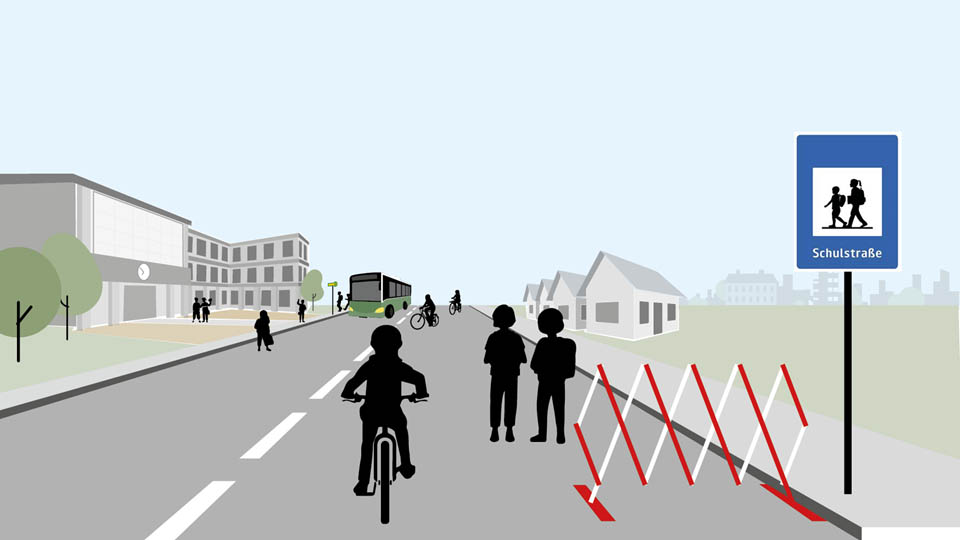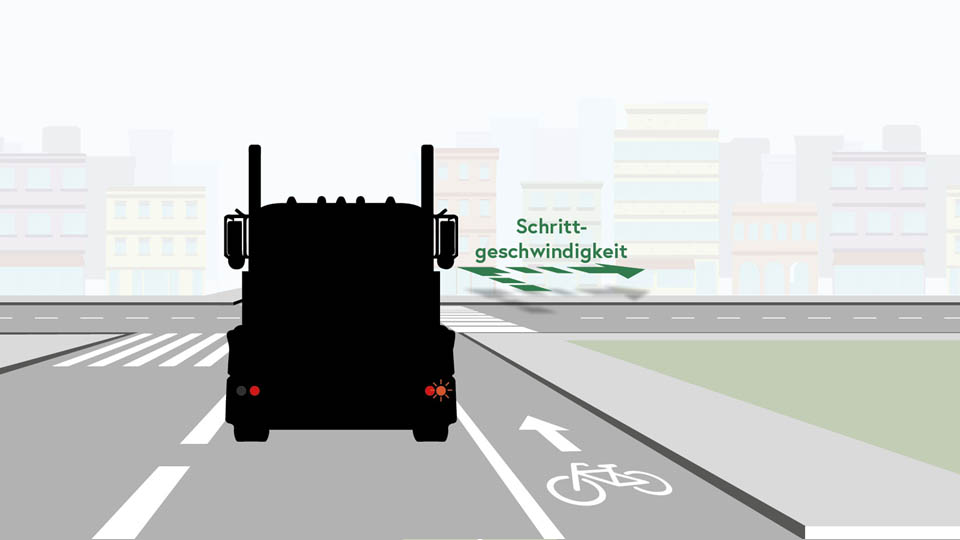The new cyclefriendly Austrian Road Code
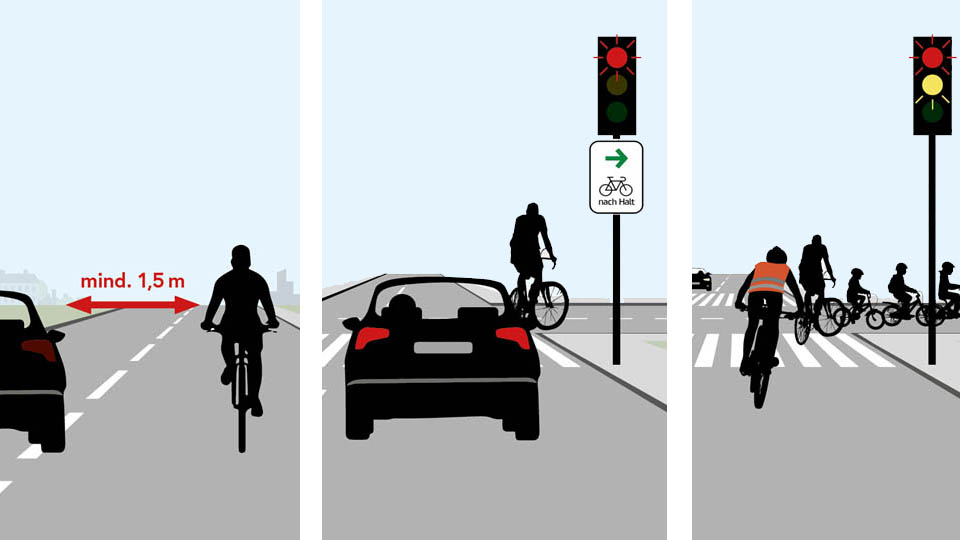
On the 1st of October the new Austrian road traffic code comes into effect. It contains important improvements for cyclists and pedestrians. Some of its highlights include ‘right turns on red’, minimum overtaking distances for cars, and legalising riding two abreast. The amendment also contains minor flaws and misses two important original proposals from the draft version.
You can read all the details about the former draft version in this article. Below we explain the most important changes with graphic representations by our member klimaaktiv mobil, the initiative of the Austrian Ministry of Climate Protection.
Introduction of ‘right turn on red’
Towns and cities now have the opportunity to allow cycle traffic to turn right through a red light, using an additional sign. Cyclists must first stop, as if at a stop sign and then give way to crossing pedestrians before making their turn. At T-Junctions, cycling straight on through a red light will be allowed. However, this will only be implemented in locations in which ‘there is no reason to believe that the safety of cyclists and other traffic could in any way be put at risk’, which will be defined in guidelines.
Clearly defined overtaking distances
In urban areas, motorised traffic must give cyclists at least 1.5m space when overtaking.
Outside of urban areas the minimum legal overtaking distance is 2m. Up to 30 km/h however, this distance can be less as long as ‘a distance and speed is maintained which ensures the safety of the vehicle being overtaken’.
Riding two abreast now legalised
Riding two abreast next to a child is now allowed on all streets except roads with tram tracks. This is a big relief to parents and others accompanying vulnerable road users under the age of 12. All grown up cyclists are only allowed to ride next to another on a normal bike on roads with a 30 km/h speed limit, except for roads with tram tracks and designated major routes. Another caveat to the rule is that it is only allowed if ‘no-one is endangered, the weight of traffic allows for it, and overtaking traffic isn’t impeded’.
Junction crossing in a continuous group
Groups of ten cyclists or more are now allowed to continue crossing a junction even after the light has turned red. Some conditions apply however: ‘riders entering the junction must obey the applicable rights of way, the leading cyclists must make the end of the group clear to other road users through the use of hand signals and if needs be, get off of the bike in order to do so and the first and last riders of the group must wear reflective vests’.
Improvements to bike crossings
The rule still applies that cyclists approaching bike crossings without traffic lights must reduce their speed to a maximum of 10 km/h, in order avoid ‘crossing directly in front of a vehicle in an unpredictable and unexpected way’, however this rule now only applies ‘when a motorised vehicle is in the direct vicinity of a junction’.
Fast E-Bikes allowed on regional cycle routes
S-Pedelecs (e-bikes with a top speed of 45 km/h which must be fitted with a number plate) along with agricultural traffic will now be allowed on cycle paths and on mixed-use pedestrian and cycle paths outside of urban areas. They must all adhere to a maximum speed of 25 km/h when using these paths.
Traffic calming “Schulstraße” implementation by traffic sign
The “Schulstraße” area in front of a school building, designated as a traffic-calmed zone, will get its own new signage prohibiting motorised traffic during certain times and making the school only accessible on foot or by bicycle. The implementation of a “Schulstraße” is now made easier by the fact that universal signage will be introduced for this purpose.
Trucks have to slow down when turning right
HGVs will be restricted to walking speed when turning right if there are pedestrians or cyclists in close proximity. More specifically: ‘if there is the possibility of cycle traffic travelling straight ahead, cycle traffic turning right from the travelled route, or the possibility of pedestrians in the immediate vicinity of the junction’.
What else is new in the road code?
- Easier implementation of bike-priority streets: the German model of bike-priority streets is to be adopted (see picture), making
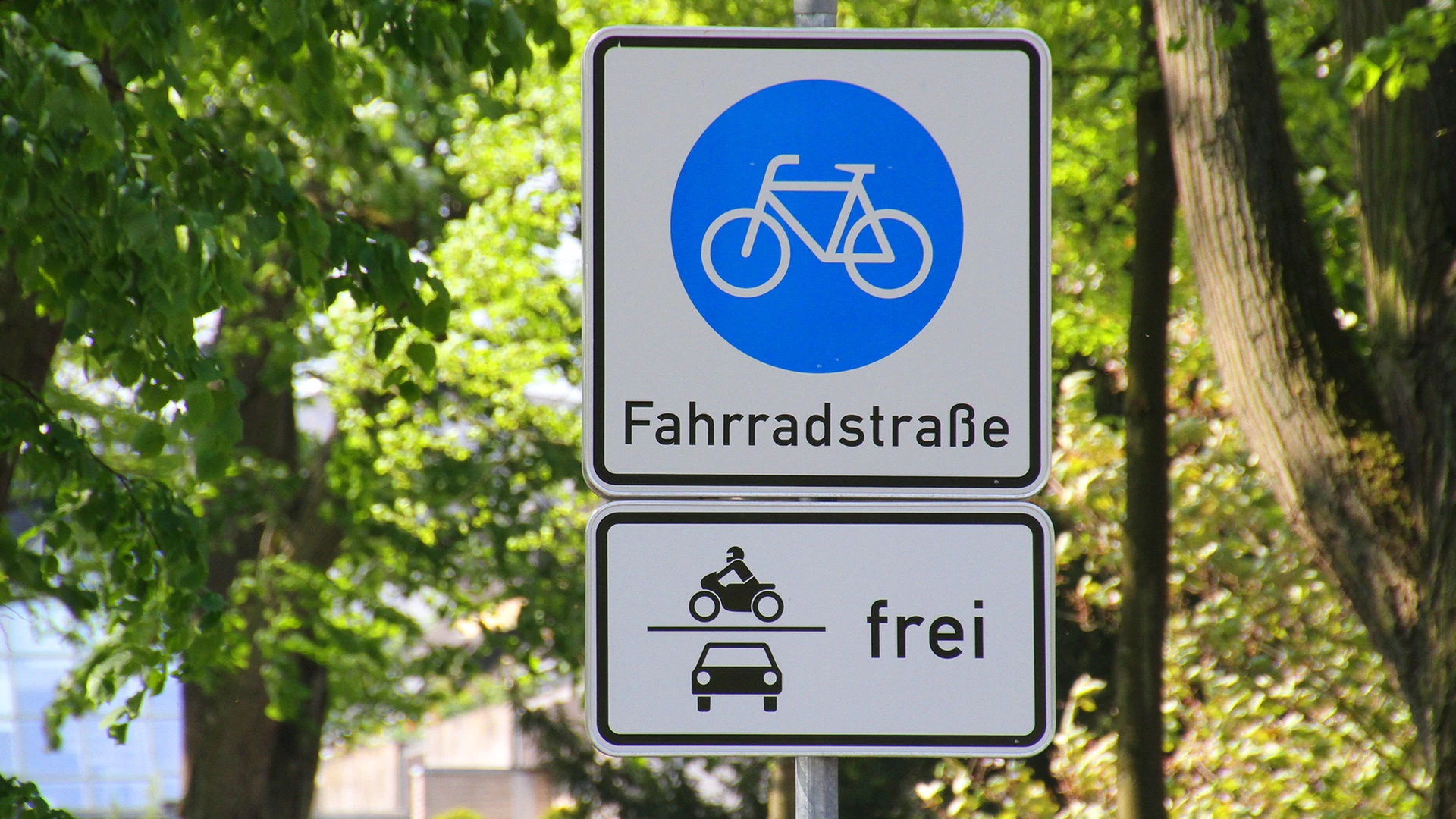 their implementation much more attractive to planners. This model allows for motorised through-traffic ‘for certain reasons or at certain times of day, depending on specific situational requirements and needs’.
their implementation much more attractive to planners. This model allows for motorised through-traffic ‘for certain reasons or at certain times of day, depending on specific situational requirements and needs’. - Clarity regarding fines: if cyclists are missing one or more legally required pieces of equipment, such as a bell, lights or reflectors, one fine will be applied rather than multiple fines based on individual items.
- Bike parking in pedestrianised areas: currently, cyclists are only allowed to park their bikes in pedestrianised areas for the length of time for which they are active in the area, and during the hours in which the pedestrian zone is used by traffic. In future bike parking in these areas will be allowed 24/7.
- Pedestrians will be prioritised at traffic lights. The green phase for pedestrians will be made longer, the red phase for motor traffic shorter.
- Motor vehicles will be explicitly prohibited from blocking or impinging on areas designated for foot and cycle traffic such as foot and bike paths.
- Driving or riding past the side of trams and busses from which passengers exit at stops will no longer be allowed. This will apply to cyclists as well as motor vehicles to increase the safety of pedestrians.
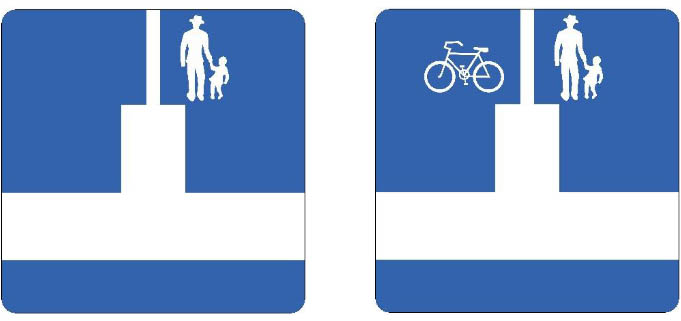
- New signage showing through-route access for pedestrians and cyclists will be mounted in cul-de-sacs. These signs will also indicate the distance and direction to the nearest electric charging station. The current directional signage for cycle routes will also be officially included in the traffic code.
- Pedestrians are still required to use a marked crossing (traffic lights, zebra crossing, pelican crossing) if they are no more than 25m away from one, however the new rules stipulate that this is no longer strictly necessary ‘if it is beyond doubt that the traffic conditions allow the street to be crossed safely and without disrupting or hindering traffic’.
- Pedestrians are now allowed to cross directly to a traffic island or public transport stop if the traffic is neither regulated by lights or manually by traffic officers.
Cycle Competence video from France
How “Turning right at red lights” works in Paris:
Alle Grafiken: BMK/unart
Cycling Competence Members in this article:
More articles with this member:
Share this article:
The new cyclefriendly Austrian Road Code
Share this article:

On the 1st of October the new Austrian road traffic code comes into effect. It contains important improvements for cyclists and pedestrians. Some of its highlights include ‘right turns on red’, minimum overtaking distances for cars, and legalising riding two abreast. The amendment also contains minor flaws and misses two important original proposals from the draft version.
You can read all the details about the former draft version in this article. Below we explain the most important changes with graphic representations by our member klimaaktiv mobil, the initiative of the Austrian Ministry of Climate Protection.
Introduction of ‘right turn on red’
Towns and cities now have the opportunity to allow cycle traffic to turn right through a red light, using an additional sign. Cyclists must first stop, as if at a stop sign and then give way to crossing pedestrians before making their turn. At T-Junctions, cycling straight on through a red light will be allowed. However, this will only be implemented in locations in which ‘there is no reason to believe that the safety of cyclists and other traffic could in any way be put at risk’, which will be defined in guidelines.
Clearly defined overtaking distances
In urban areas, motorised traffic must give cyclists at least 1.5m space when overtaking.
Outside of urban areas the minimum legal overtaking distance is 2m. Up to 30 km/h however, this distance can be less as long as ‘a distance and speed is maintained which ensures the safety of the vehicle being overtaken’.
Riding two abreast now legalised
Riding two abreast next to a child is now allowed on all streets except roads with tram tracks. This is a big relief to parents and others accompanying vulnerable road users under the age of 12. All grown up cyclists are only allowed to ride next to another on a normal bike on roads with a 30 km/h speed limit, except for roads with tram tracks and designated major routes. Another caveat to the rule is that it is only allowed if ‘no-one is endangered, the weight of traffic allows for it, and overtaking traffic isn’t impeded’.
Junction crossing in a continuous group
Groups of ten cyclists or more are now allowed to continue crossing a junction even after the light has turned red. Some conditions apply however: ‘riders entering the junction must obey the applicable rights of way, the leading cyclists must make the end of the group clear to other road users through the use of hand signals and if needs be, get off of the bike in order to do so and the first and last riders of the group must wear reflective vests’.
Improvements to bike crossings
The rule still applies that cyclists approaching bike crossings without traffic lights must reduce their speed to a maximum of 10 km/h, in order avoid ‘crossing directly in front of a vehicle in an unpredictable and unexpected way’, however this rule now only applies ‘when a motorised vehicle is in the direct vicinity of a junction’.
Fast E-Bikes allowed on regional cycle routes
S-Pedelecs (e-bikes with a top speed of 45 km/h which must be fitted with a number plate) along with agricultural traffic will now be allowed on cycle paths and on mixed-use pedestrian and cycle paths outside of urban areas. They must all adhere to a maximum speed of 25 km/h when using these paths.
Traffic calming “Schulstraße” implementation by traffic sign
The “Schulstraße” area in front of a school building, designated as a traffic-calmed zone, will get its own new signage prohibiting motorised traffic during certain times and making the school only accessible on foot or by bicycle. The implementation of a “Schulstraße” is now made easier by the fact that universal signage will be introduced for this purpose.
Trucks have to slow down when turning right
HGVs will be restricted to walking speed when turning right if there are pedestrians or cyclists in close proximity. More specifically: ‘if there is the possibility of cycle traffic travelling straight ahead, cycle traffic turning right from the travelled route, or the possibility of pedestrians in the immediate vicinity of the junction’.
What else is new in the road code?
- Easier implementation of bike-priority streets: the German model of bike-priority streets is to be adopted (see picture), making
 their implementation much more attractive to planners. This model allows for motorised through-traffic ‘for certain reasons or at certain times of day, depending on specific situational requirements and needs’.
their implementation much more attractive to planners. This model allows for motorised through-traffic ‘for certain reasons or at certain times of day, depending on specific situational requirements and needs’. - Clarity regarding fines: if cyclists are missing one or more legally required pieces of equipment, such as a bell, lights or reflectors, one fine will be applied rather than multiple fines based on individual items.
- Bike parking in pedestrianised areas: currently, cyclists are only allowed to park their bikes in pedestrianised areas for the length of time for which they are active in the area, and during the hours in which the pedestrian zone is used by traffic. In future bike parking in these areas will be allowed 24/7.
- Pedestrians will be prioritised at traffic lights. The green phase for pedestrians will be made longer, the red phase for motor traffic shorter.
- Motor vehicles will be explicitly prohibited from blocking or impinging on areas designated for foot and cycle traffic such as foot and bike paths.
- Driving or riding past the side of trams and busses from which passengers exit at stops will no longer be allowed. This will apply to cyclists as well as motor vehicles to increase the safety of pedestrians.

- New signage showing through-route access for pedestrians and cyclists will be mounted in cul-de-sacs. These signs will also indicate the distance and direction to the nearest electric charging station. The current directional signage for cycle routes will also be officially included in the traffic code.
- Pedestrians are still required to use a marked crossing (traffic lights, zebra crossing, pelican crossing) if they are no more than 25m away from one, however the new rules stipulate that this is no longer strictly necessary ‘if it is beyond doubt that the traffic conditions allow the street to be crossed safely and without disrupting or hindering traffic’.
- Pedestrians are now allowed to cross directly to a traffic island or public transport stop if the traffic is neither regulated by lights or manually by traffic officers.
Cycle Competence video from France
How “Turning right at red lights” works in Paris:
Alle Grafiken: BMK/unart

